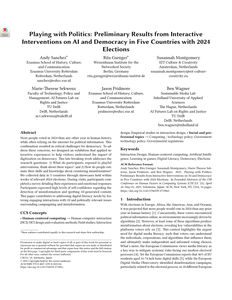To bridge the gap between design practice and academic design research, no off the shelf methods exist for practitioners to contribute to the body of literature. Practitioners face epistemological challenges that disable generalizing their expertise. Dewey’s pragmatism recasts these challenges empowers practitioners to conduct design research trough experimentation and reflection on outcomes. A methodology, based on Dewey's inquiry, is presented and tested, demonstrating it offers rigor for practitioners to contribute to the academic debate. At the same time the method somewhat lacked the volatility practice demands, requiring adaptation.
LINK
More people voted in 2024 than any other year in human history, while often relying on the internet for political information. This combination resulted in critical challenges for democracy. To address these concerns, we designed an exhibition that applied interactive experiences to help visitors understand the impact of digitization on democracy. This late-breaking work addresses the research questions: 1) What do participants, exposed to playful interventions, think about these topics? and 2) How do people estimate their skills and knowledge about countering misinformation? We collected data in 5 countries through showcases held within weeks of relevant 2024 elections. During visits, participants completed a survey detailing their experiences and emotional responses. Participants expressed high levels of self-confidence regarding the detection of misinformation and spotting AI-generated content. This paper contributes to addressing digital literacy needs by fostering engaging interactions with AI and politically relevant issues surrounding campaigning and misinformation.
MULTIFILE

The Best Practice Unit (BPU) model constitutes a unique form of practice-based research. A variant of the Community of Practice model developed by Wenger, McDermott and Snyder (2002), the BPU has the specific aim of improving professional practice by combining innovation and research. The model is used as a way of working by a group of professionals, researchers and other relevant individuals, who over a period of one to two years, work together towards a desired improvement. The model is characterized by interaction between individual and collective learning processes, the development of new or improved working methods, and the implementation of these methods in daily practice. Multiple knowledge resources are used, including experiential knowledge, professional knowledge and scientific knowledge. The research serves diverse purposes: articulating tacit knowledge, documenting learning and innovation processes, systematically describing the working methods that have been revealed or developed, and evaluating the efficacy of the new methods. Each BPU is supported by a facilitator, whose main task is to optimize learning processes. An analysis of ten different BPUs in different professional fields shows that this is a successful model. The article describes the methodology and results of this study.
DOCUMENT

It is a well-known fact that a good preparation in the pre-departure stage can maximize the chances of a succesful foreign experience. But what is meant by a good preparation? And what are the expected results of such a preparation? This course focuses in internship and study abroad (pre-departure) preparation. Its aim is to prepare you for the personal, professional and academic challenges of living and working abroad. The course will address awareness and purpose in the acquisition of attitude, knowledge and skills related to international competencies.
DOCUMENT
